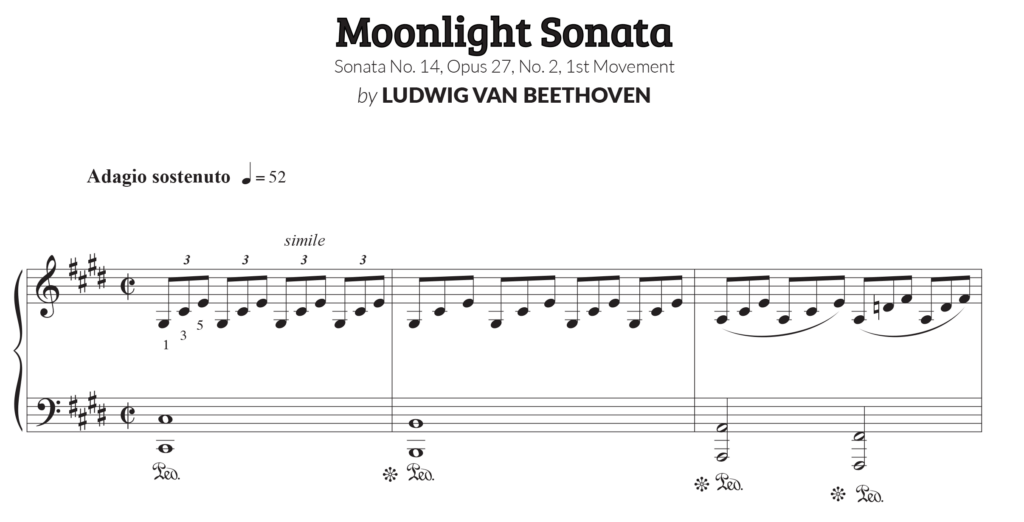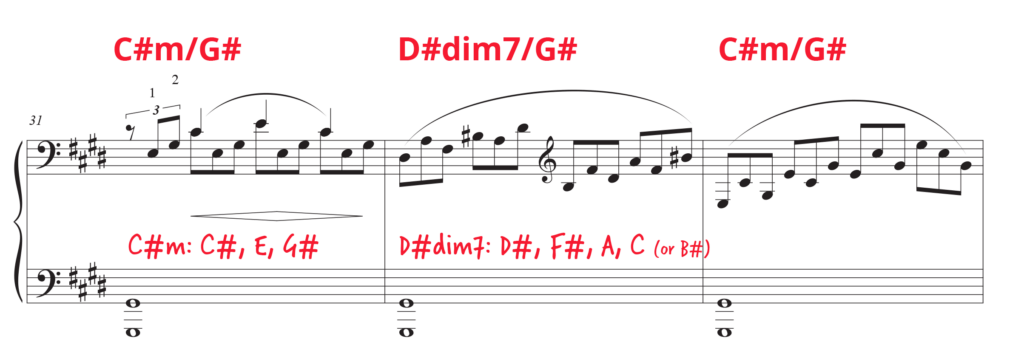This is possibly the most detailed Moonlight Sonata tutorial on the internet, complete with a free Moonlight Sonata sheet music download. Welcome!
Beethoven’s Piano Sonata No. 14, otherwise known as the Moonlight Sonata, is one of his most beloved pieces and one of the most famous piano pieces of all time. This iconic work is a must-play for pianists. It’s also not too easy and not too hard, which makes it perfect for intermediate piano players who want to take their skills to the next level.
Table of Contents:
Inspiring tutorials. Fascinating articles. Exclusive interviews. We create piano content anyone, anywhere can enjoy for free. Don’t miss out, sign up for more free lessons.
Before we start, make sure to download your free copy of the sheet music to “Moonlight” Sonata. Click the red button right here!

Beethoven never called this sonata Moonlight. That nickname was given by another Ludwig, Ludwig Rellstab, a critic who thought the sonata reminded him of the moonlight reflecting off Lake Lucerne in Switzerland. Beethoven himself dedicated the sonata to Countess Giulietta Guicciardi, one of his students.
Piano Sonata No. 14 is unique in that it doesn’t follow typical sonata conventions. Sonatas generally have a fast first movement, a slow middle movement, and then a fast final movement. No. 14 instead opens up with a slow movement, followed by a moderately-fast one, before ending on a very fast third movement.

The Moonlight Sonata has some challenging parts, but it’s worth it! Practice the piece section by section and pay attention to parts you may have seen before. Music is all about recognizing patterns.
🔥🎹 HOT TIP! One way to help mentally structure related parts of Moonlight is to learn about sonata structure and how it applies to the first movement.This is a piece where flats and sharps change a lot. When encountering accidentals, remember: if a note gets an accidental, that accidental lasts for the entire measure. When you’re just starting out, it might be helpful to write down the accidentals on your sheet music.

You’ll also encounter double-sharps in this piece. They look like this: 𝄪. This means you raise the double-sharped note by two half-steps. F𝄪 is, in other words, G natural.

Fingering can feel overwhelming in this piece because there are so many changing and moving parts. But trust in your muscle memory. It’ll get easier as you practice. We promise!
And remember: fingerings aren’t set in stone. You can’t change up the fingering if another combination feels better.

Love this tutorial? Subscribe to The Note for more tutorials, quick tips, cheat sheets, explainers, and other stuff piano players love. Delivered to your inbox for free.
There are some stretches in this piece that are wider than an octave. If you struggle to reach ninths, you can roll into them. You can also just play the melody note.
Another idea is to use your other hand to “cheat.” For example, in this part of the song, the pedal keeps the bass note sustained, which means your left hand isn’t busy. You can then use it to play that B if your right hand can’t comfortably reach it.

Remember to bring out the melody by playing this top line louder and the accompanying parts softer. Pay attention to the directions of stems. They clue you in to where the melody is.

The melody also switches to the left hand at around measure 60:

Rubato means “robbed time” and it’s when you push and pull on the tempo, slowing down and speeding up, to add more expression to the piece. While it’s possible to overdo rubato, there’s no right or wrong way to do it. So experiment with tempo and lean in to what the piece feels like for you.
There are parts in this piece that may seem overwhelmingly complicated! But take a deep breath and see if you can spot any patterns.
In this section, what at first looks like a big mess of notes is just chords in inversion patterns. The same notes get played over and over, just in a different order.

Learning how to play this piece is an investment. You’re not meant to learn it in a day!
If you feel overwhelmed, try dividing the piece into sections and practice section by section or page by page. You’ll learn that there are repeating patterns. So while the first movement is six pages of sheet music, you’re not learning six pages of new material.
You can do this!
One way to master a new classical piece like is to use our Practice-Along feature in the Pianote Members Area. Not a Member yet? No problem! Try out membership tools and perks with a 7-day trial:
Lisa Witt has been teaching piano for more than 20 years and in that time has helped hundreds of students learn to play the songs they love. Lisa received classical piano training through the Royal Conservatory of Music, but she has since embraced popular music and playing by ear in order to accompany herself and others. Learn more about Lisa.


By signing up you’ll also receive our ongoing free lessons and special offers. Don’t worry, we value your privacy and you can unsubscribe at any time.
We use cookies for traffic data and advertising. Cookie Policy »